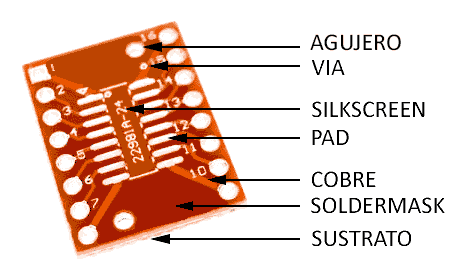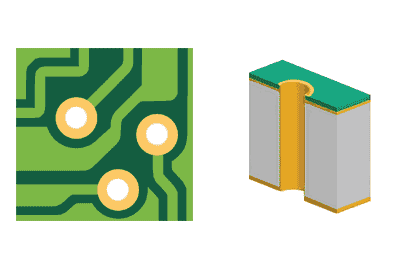We continue with the tutorial section to design our own PCBs, looking at what traces are and their almost indispensable role in the design of our electronic circuits.
In previous posts, we have already seen the parts of a PCB and the internal structure, seeing what the layers of a PCB are.
In this post, we saw that having several layers allows us to make more compact circuits, since it is equivalent to having more surface area, increasing with the number of layers.
 We still need to see how the conductor layers communicate vertically, and this is where the traces come into play. A trace is a vertical hole, usually small in size, which has copper inside and connects the top layer with the inner layer.
We still need to see how the conductor layers communicate vertically, and this is where the traces come into play. A trace is a vertical hole, usually small in size, which has copper inside and connects the top layer with the inner layer.
Traces should not be confused with the holes of some pads to place PTH components. Usually, traces have a very small size.

Together, horizontal traces and vertical traces form the electrical circuits. Therefore, both are equally important in our PCBs.
Furthermore, as we mentioned in the previous post, due to the mathematics and typology, it can be demonstrated that a single-layer board cannot perform any type of circuit.
If we have a crossing of traces, it is possible that we have a geometric arrangement that does not allow us to make all the connections in a single plane.
However, if we have two layers, things change. If we come across another trace or a crossing, we can put a trace, pass to the other side of the PCB, and continue with our trace from there.

On the other hand, we already mentioned that in this section of posts we are going to focus especially on two-layer PCBs, mainly because they are the ones we can acquire at a low price.
However, we cannot fail to indicate that, in the case of PCBs with more layers, there are also traces that connect the inner layers. These are classified as:
- Through, start and end on an outer layer.
- Blind, start on an outer layer and end on an inner layer.
- Buried, start and end on an inner layer.

As we have seen, traces are an essential element that we will inevitably use in our boards. However, a good PCB design should generally minimize the number of traces used.
A good arrangement of the components, an intelligent and thoughtful layout of the traces, contribute to eliminating the need to make crossovers from one layer to another.
In fact, it is common that, after finishing designing a part of the PCB, we spend some time thinking if we can find a way to change the layout in a way that reduces the need to go from side to side.
So far, this post is dedicated to our trace friends on a PCB; understanding their construction and their necessity in our designs.
And now that we have seen the most important parts of a PCB, and so that we can finally stop being afraid of them, in the next post we are going to briefly see how a PCB is manufactured. See you soon!
